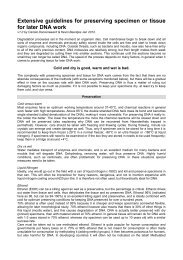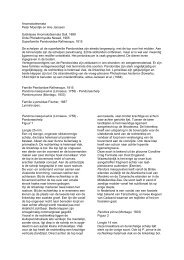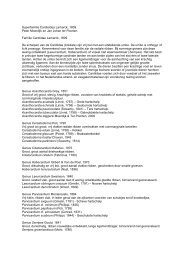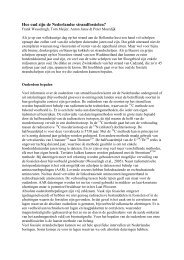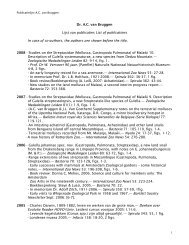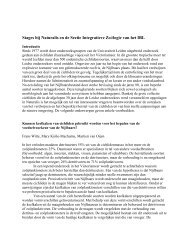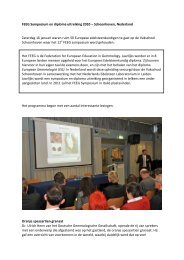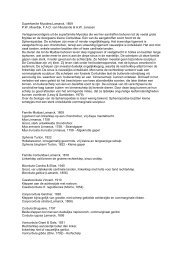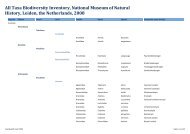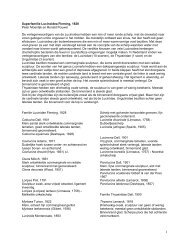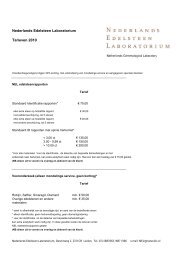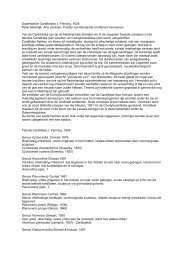The Odonata of Sulawesi and adjacent islands ... - science . naturalis
The Odonata of Sulawesi and adjacent islands ... - science . naturalis
The Odonata of Sulawesi and adjacent islands ... - science . naturalis
You also want an ePaper? Increase the reach of your titles
YUMPU automatically turns print PDFs into web optimized ePapers that Google loves.
Variation<br />
van Tol<br />
Insignificant variation in coloration. Measurements [mm]: abdomen 16-18, Hw 21-23.<br />
Biology<br />
Males are territorial in middle <strong>of</strong> larger streams in Minahasa. <strong>The</strong>y hold a position<br />
on stones or logs just a cm above the water surface, where they are frequently disturbed<br />
by larger waves. A female (JvT 4934, Dumoga Bone NP) oviposited in a piece<br />
<strong>of</strong> dead wood, ca 5 cm under water (observation J. van Tol).<br />
Distribution<br />
Widespread in Minahasa, with scattered records west <strong>of</strong> this region (Fig. 7). Apparently<br />
not rare in the Gorontalo area in the 1940s, but no recent records, presumably<br />
due to little collecting effort since that time. <strong>The</strong> record in Central <strong>Sulawesi</strong><br />
near Onang, 58 km N <strong>of</strong> Majene, is <strong>of</strong> particular interest. It is far from other known<br />
sites, but this species is almost certainly absent from the mountainous areas south <strong>of</strong><br />
Palu. Remarkably, L. rufescens was collected on the same site, also rather isolated<br />
from the rest <strong>of</strong> its otherwise southern range. Both lowl<strong>and</strong> species apparently<br />
dispersed along the coastal area. Due to widespread disturbance <strong>and</strong> pollution <strong>of</strong><br />
the original habitats both species are now rare outside their distributional centres.<br />
Etymology<br />
Libellago manganitu sp. nov.<br />
(Figs 2g, 3g, 4g)<br />
Manganitu, after the type locality. A noun in apposition.<br />
Specimens examined<br />
Holotype P (JvT 5352, in RMNH): “Sangihe Isl<strong>and</strong>s, Manganitu: riverine gardens,<br />
coconut plantations, secondary forest, 3°35'N 125°32'E, 10-25 May 1985, F.G. Rozendaal”.<br />
— Paratypes (all in RMNH): 5 P, 8 O (JvT 1758, 5350-5351, 5353-5362),<br />
same site as holotype; 1 P (JvT 5363), Sangihe Isl<strong>and</strong>s, SSW <strong>of</strong> Liwung, NW slope<br />
Gn [Gunung] Sahendaruman (600-650 m), primary forest <strong>and</strong> forest edge, water<br />
trickle <strong>and</strong> small stream, 12/19 v 1985, F.G. Rozendaal.<br />
Diagnosis<br />
A rather delicate Libellago, Hw ca 22 mm. Presumably closely related species to<br />
L. daviesi sp. nov., based on general coloration, thickened Costa, <strong>and</strong> white innerside<br />
<strong>of</strong> tibiae, but pale markings on head blue (not yellow); yellow markings <strong>of</strong> synthorax<br />
pale yellow rather than dark yellow; Costa thickened over 1 or 2 cells anterior<br />
to nodus (not from Ax2), <strong>and</strong> dark pattern <strong>of</strong> abdomen only complete on S1-2.<br />
Wings remarkably narrow.<br />
234<br />
International Journal <strong>of</strong> Odonatology 10 (2) 2007: 209-248, pls II, III



